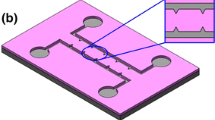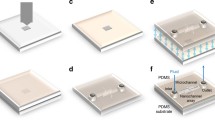Abstract
Polymer micro- and nanofluidic chips become increasingly significant for medical and biological applications. However, it is difficult to fabricate micro- and nanochannels integrately into a polymer substrate due to the reflow and insufficient flow of the polymer. In the present paper, micro- and nanochannels were hot embossed into a multilayer substrate by micromold and nanomold, respectively. To replicate high replication precision nanochannels without damaging the fabricated microchannels, the embossing parameters were optimized by Taguchi and analytic hierarchy process methods. The fabricated micro- and nanochannels were fully sealed at bonding parameters optimized according to the bonding rate of the chip. The fluorescence image indicates that there is no blocking or leakage over the entire micro- and nanochannels. With presented fabrication method, low-cost polymer micro- and nanostructures can be fabricated, which allows for commercial manufacturing of micro- and nanofluidic chips.






Similar content being viewed by others
References
Chantiwas R et al (2011) Flexible fabrication and applications of polymer nanochannels and nanoslits. Chem Soc Rev 40(7):3677–3702
Cheng E et al (2014) Experimental and numerical study on deformation behavior of polyethylene terephthalate two-dimensional nanochannels during hot embossing process. J Micromech Microeng 24(1):015004
Chiu SH et al (2017) Multi-objective optimization of process parameters in an area-forming rapid prototyping system using the Taguchi method and a grey relational analysis. Proc Inst Mech Eng B J Eng Manuf 231(12):2211–2222
Cho YH et al (2009) Fabrication of high-aspect-ratio polymer nanochannels using a novel Si nanoimprint mold and solvent-assisted sealing. Microfluid Nanofluid 9(2–3):163–170
Chong KSL, Lee Y-Y, Low HY (2011) Recessed area patterning via nanoimprint lithography. J Vac Sci Technol B 29(6):060602
Chun DW et al (2013) Fast myoglobin detection using nanofluidic electrokinetic trapping technique. Appl Phys Express 6(1):017001
Dong S-H, Zhang J, Ge S-X (2016) Microfluidic chips for cell capturing and separation. Prog Biochem Biophys 43(11):1102–1110
Du L et al (2012) A method of water pretreatment to improve the thermal bonding rate of PMMA microfluidic chip. Microsyst Technol Micro Nanosyst Inf Storage Process Syst 18(4):423–428
Fanzio P et al (2011) DNA detection with a polymeric nanochannel device. Lab Chip 11(17):2961–2966
Gillespie D, Pennathur S (2013) Separation of ions in nanofluidic channels with combined pressure-driven and electro-osmotic flow. Anal Chem 85(5):2991–2998
Hlushkou D et al (2012) Propagating concentration polarization and ionic current rectification in a nanochannel-nanofunnel device. Anal Chem 84(1):267–274
Levy SL et al (2008) Entropic unfolding of DNA molecules in nanofluidic channels. Nano Lett 8(11):3839–3844
Li S-H (2013) Research on evaluation system of new energy vehicles based on AHP. Trans Tech Publications, Malaysia
Mohammadi F, Mohammadi T (2017) Optimal conditions of porous ceramic membrane synthesis based on alkali activated blast furnace slag using Taguchi method. Ceram Int 43(16):14369–14379
Okuda K et al (2007) Micro-nano mixture patterning by thermal-UV novel nanoimprint. J Vac Sci Technol B 25(6):2370–2372
Pedersen JN et al (2013) Fully streched single DNA molecules in a nanofluidic chip show large-scale structural variation. Biophys J 104(2):175A
Rong Y et al (2009) Fabrication of micro/nano fluidic channels by nanoimprint lithography and bonding using SU-8. Microelectron Eng 86(4–6):1379–1381
Sang J et al (2013) Protein sensing by nanofluidic crystal and its signal enhancement. Biomicrofluidics 7(2):024112
Scaffaro R, Sutera F, Lopresti F (2017) Using Taguchi method for the optimization of processing variables to prepare porous scaffolds by combined melt mixing/particulate leaching. Mater Des 131:334–342
Schoch RB, Han J, Renaud P (2008) Transport phenomena in nanofluidics. Rev Mod Phys 80(3):839–883
Takagi H et al (2008) Analysis of time dependent polymer deformation based on a viscoelastic model in thermal imprint process. Microelectron Eng 85(5–6):902–906
Thamdrup LH, Klukowska A, Kristensen A (2008) Stretching DNA in polymer nanochannels fabricated by thermal imprint in PMMA. Nanotechnology 19(12):125301
Tsukahara T (2010) Nanofluidic-based separation system of radionuclide ions by controlling electrostatic forces. Bull Res Lab Nucl React 34(1):51
van Kan JA et al (2012) High throughput fabrication of disposable nanofluidic lab-on-chip devices for single molecule studies. Biomicrofluidics 6(3):036502
Viefhues M, Regtmeier J, Anselmetti D (2012) Nanofluidic devices for dielectrophoretic mobility shift assays by soft lithography. J Micromech Microeng 22(11):115024
Wang X, Li Y, Cui W (2012) Design and implementation of a collaboration-based AHP evaluation system. IEEE Computer Society, Wuhan
Xing C, Guo LJ (2004) One-step lithography for various size patterns with a hybrid mask-mold. Microelectron Eng 71(3–4):288–293
Xudi W et al (2009) Fabrication of enclosed nanofluidic channels by UV cured imprinting and optimized thermal bonding of SU-8 photoresist. Microelectron Eng 86(4–6):1347–1349
Yasui T et al (2011) DNA separation in nanowall array chips. Anal Chem 83(17):6635–6640
Yin Z, Cheng E, Zou H (2014) A novel hybrid patterning technique for micro and nanochannel fabrication by integrating hot embossing and inverse UV photolithography. Lab Chip 14(9):1614–1621
Zhang X, Li L, Luo C (2016) Gel integration for microfluidic applications. Lab Chip 16(10):1757–1776
Acknowledgements
This project is supported by Specialized Research Fund for the Doctoral Program of Higher Education of China (SRFDP) (No. 20120041110034) and National Natural Science Foundation of China (No. 51705198).
Author information
Authors and Affiliations
Corresponding author
Rights and permissions
About this article
Cite this article
Yin, Z., Zou, H. Multilayer patterning technique for micro- and nanofluidic chip fabrication. Microfluid Nanofluid 21, 174 (2017). https://doi.org/10.1007/s10404-017-2013-5
Received:
Accepted:
Published:
DOI: https://doi.org/10.1007/s10404-017-2013-5




